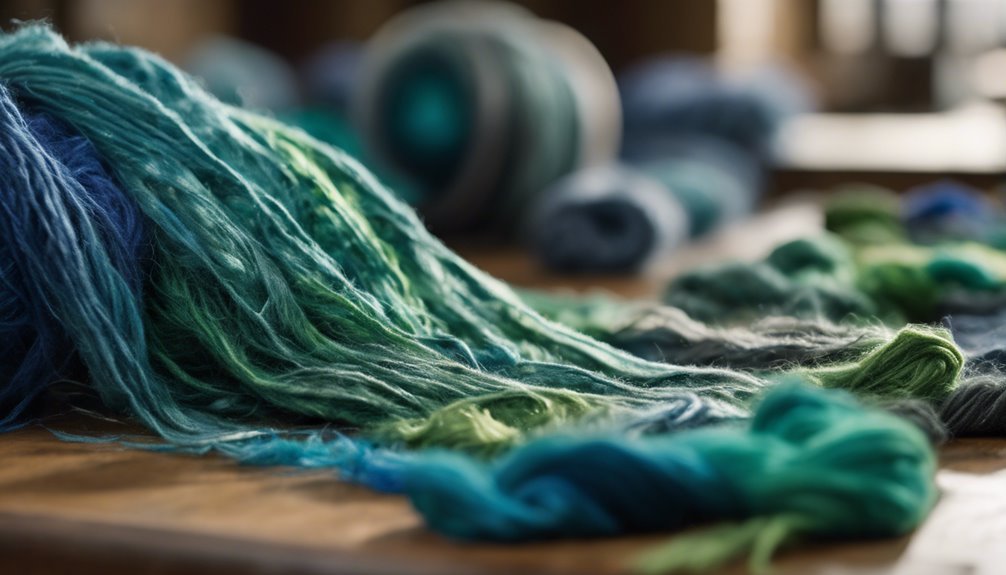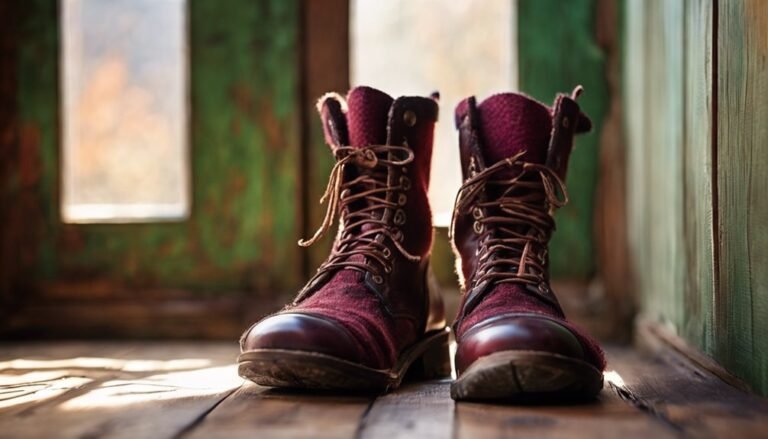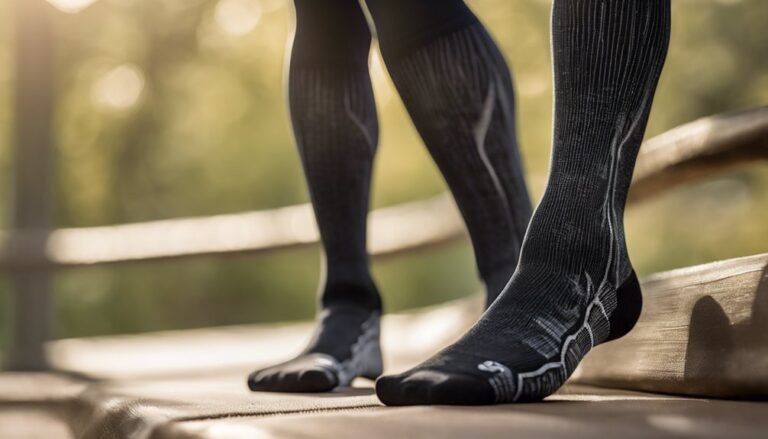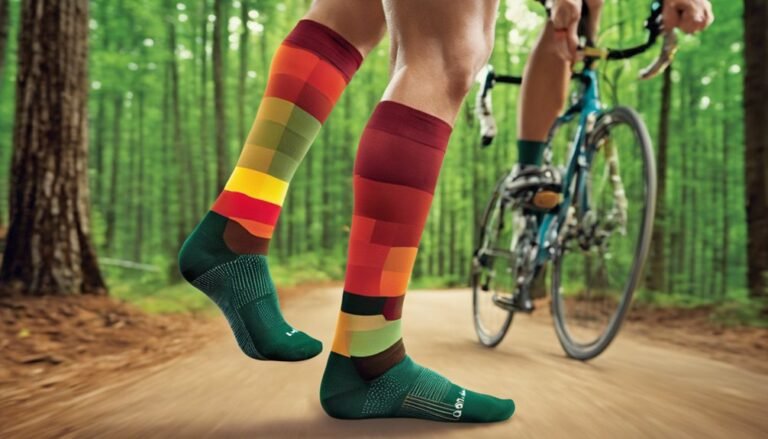How Recycled Socks Are Made: The Process Behind Sustainable Fashion
Recycled socks are made through a thoughtful process that starts with sourcing discarded textiles from local communities. Once collected, these materials are sorted by type and condition to maximize recycling potential. The fibers are then spun into yarn and woven together, creating diverse textures and colors. Sustainable packaging and efficient distribution guarantee these eco-friendly socks reach you with a minimal carbon footprint. Curious about how your new comfy socks contribute to a sustainable future? There's more to discover!
The Importance of Recycled Materials in Fashion

As the fashion industry faces increasing scrutiny over its environmental impact, the importance of recycled materials has never been clearer. By embracing sustainable sourcing, you help shift the industry toward a circular economy, where products are designed to be reused and repurposed. Recycled materials not only reduce waste but also lessen the demand for virgin resources, making a significant difference in our planet's health. Imagine wearing socks made from discarded textiles—each pair a statement of eco-consciousness. This approach fosters creativity and innovation, allowing you to express your style while contributing to a more sustainable future. Every choice you make in your wardrobe can promote a lifestyle that values freedom and responsibility, helping to redefine what fashion means in today's world.
The Collection Process: Sourcing Discarded Textiles
While many people might not realize it, the journey of recycled socks begins with the careful collection of discarded textiles. This textile sourcing is essential for creating a circular economy, where materials are reused instead of ending up in landfills. Organizations and brands often partner with local communities, encouraging you to donate old clothes and socks, ensuring they find a new purpose. These initiatives not only help reduce waste but also promote awareness about sustainable fashion. Each piece collected plays a part in transforming the way we think about consumption. By participating in this process, you contribute to a more eco-conscious future, embracing the freedom that comes with making responsible choices. Your discarded textiles can evolve into something new and useful, like stylish recycled socks!
Sorting and Processing: Preparing Materials for Recycling
Once you've collected those used socks, the next step is sorting them by material type and condition. This essential process guarantees that each sock is processed correctly for reuse, maximizing the recycling potential. By understanding these sorting techniques, you can appreciate how your old socks can transform into something new and sustainable.
Collection of Used Socks
Every year, millions of socks are tossed aside, creating a significant opportunity for recycling. By participating in sock donation programs or textile recycling initiatives, you can help divert these items from landfills. It's easier than you think! Here's how you can get involved:
- Gather Your Used Socks: Collect any unwanted, mismatched, or worn-out socks.
- Find a Local Donation Center: Search for organizations that accept sock donations or textile recycling.
- Drop Off or Mail Them: Deliver your socks in person or ship them to support sustainable fashion efforts.
Material Sorting Techniques
Material sorting is a crucial step in the recycling process, ensuring that the right fibers are separated for efficient reuse. Using advanced sorting technologies, recyclers can identify and categorize materials based on their quality and type. This careful assessment maximizes the potential for creating high-quality recycled socks.
| Sorting Technology | Material Quality |
|---|---|
| Optical Sorting | High-quality fibers |
| Manual Sorting | Variable quality |
| Automated Systems | Consistent accuracy |
| Air Classification | Lightweight materials |
Processing for Reuse
As recyclers prepare materials for reuse, understanding the processing techniques becomes essential for transforming sorted fibers into high-quality products. This process not only enhances sock durability but also supports the creation of eco-friendly fabrics. Here's how it typically unfolds:
- Fiber Separation: Different materials are sorted to guarantee compatibility, maximizing the potential for reuse.
- Cleaning and Decontaminating: Socks are washed to remove dirt and impurities, preparing them for transformation.
- Shredding: The cleaned materials are shredded into smaller pieces, facilitating easier processing and integration into new products.
Spinning and Weaving: Transforming Textiles Into Yarn

While transforming textiles into yarn might seem like a challenging process, it's actually a fascinating journey that breathes new life into recycled socks. First, fiber sourcing is essential; you'll see various materials like cotton and wool blended together. This guarantees durability and comfort in the final product. Next, the textiles go through yarn production, where they're spun into fine threads. This spinning process aligns the fibers, enhancing strength and flexibility. As the yarn is woven, it creates a rich tapestry of colors and textures, reflecting the recycled origins of the socks. By embracing this method, you're not just reducing waste—you're championing sustainable fashion. So, let's celebrate the transformation and freedom that comes with eco-friendly choices!
Knitting Techniques: Crafting the Perfect Sock
How can you create the perfect sock that's both comfortable and eco-friendly? It all starts with understanding sock construction and the right knitting patterns. By choosing sustainable materials and innovative techniques, you can craft socks that feel great and help the planet. Here are three essential tips for your knitting journey:
- Select Eco-Friendly Yarn: Look for recycled fibers or organic materials that reduce environmental impact.
- Experiment with Knitting Patterns: Play with various designs to enhance comfort and style; ribbing can improve fit while adding flair.
- Focus on Fit: Pay attention to sizing and elasticity; well-fitted socks prevent discomfort and slippage.
With these techniques, you'll be on your way to knitting the perfect eco-conscious sock!
Packaging and Distribution: Bringing Recycled Socks to Consumers
When it comes to getting your recycled socks into your hands, sustainable packaging and efficient distribution are key. You'll find that many brands prioritize eco-friendly materials and delivery methods to minimize their carbon footprint. By choosing brands that care about their environmental impact, you're not just getting great socks—you're supporting a greener future.
Sustainable Packaging Solutions
As consumers increasingly prioritize eco-friendliness, brands are stepping up their game with sustainable packaging solutions that reflect their commitment to the environment. You'll find that many companies are now using biodegradable materials to guarantee their packaging decomposes naturally, reducing landfill waste. Here are three innovative approaches you might appreciate:
- Plant-Based Plastics: These alternatives break down more easily than traditional plastics, offering a greener option.
- Recycled Paper: Utilizing recycled paper reduces the need for new resources, promoting minimal waste.
- Minimalist Designs: Brands are adopting simple packaging designs, limiting excess materials and focusing on functionality.
Efficient Distribution Channels
While many brands focus on creating recycled socks, the journey to consumers is just as important, and efficient distribution channels play a crucial role in that process. By streamlining the supply chain, brands can guarantee their eco-friendly products reach you without unnecessary delays. This efficiency helps boost consumer awareness about sustainable fashion, making it easier for you to make informed choices. Transparent distribution practices not only enhance trust but also empower you to support brands committed to environmental responsibility. When you choose recycled socks, you're part of a larger movement that values sustainability and ethical practices. Ultimately, efficient distribution channels make it possible for you to enjoy stylish, eco-conscious products while contributing to a healthier planet.
Eco-Friendly Delivery Methods
Eco-friendly delivery methods are essential for ensuring that your recycled socks arrive with minimal environmental impact. By utilizing green logistics, companies can markedly reduce their carbon footprint during the packaging and distribution processes. Here are three effective eco-friendly delivery methods you should know about:
- Biodegradable Packaging: Instead of plastic, brands use materials that break down naturally, reducing waste.
- Local Distribution Centers: By shipping from nearby locations, companies cut down on transportation emissions and speed up delivery times.
- Carbon Offsetting: Some brands invest in renewable energy projects to counterbalance their emissions, making your purchase even greener.
Frequently Asked Questions
Can I Recycle Socks at Home?
Yes, you can recycle socks at home! Use creative methods like cutting them into rags, crafting pet toys, or donating them. Every small effort contributes to sock recycling and makes your eco-conscious lifestyle even more fulfilling.
What Materials Are Commonly Used in Recycled Socks?
Did you know around 60% of textile waste can be recycled? When it comes to recycled socks, materials like reclaimed cotton, polyester, and wool transform into sustainable textiles, reducing waste while giving you cozy, eco-friendly comfort.
How Do Recycled Socks Compare to New Ones in Quality?
When comparing recycled socks to new ones, you'll find that while recycled options often boast sustainability benefits, the durability comparison can vary. Many recycled socks hold up well, offering both eco-consciousness and comfort for your feet.
Are Recycled Socks Eco-Friendly?
Aren't you curious about how your choices affect the planet? Recycled socks use sustainable materials, greatly reducing their environmental impact. By choosing them, you're embracing eco-friendliness while enjoying comfort and style—who wouldn't want that?
What Brands Specialize in Recycled Socks?
You'll find several sustainable brands specializing in recycled socks, like Bombas and Conscious Step. They're leading sock innovations that combine comfort and eco-friendliness, giving you stylish choices while supporting a healthier planet.






